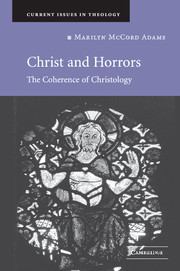Book contents
- Frontmatter
- Contents
- Preface
- 1 Christology as natural theology: methodological issues
- 2 Posing the problems: beginning with Job
- 3 Sharing the horrors: Christ as horror-defeater
- 4 Psychologizing the person: Christ as God-man, psychologically construed
- 5 Recovering the metaphysics: Christ as God-man, metaphysically construed
- 6 Learning the meanings: Christ in the hearts of all people
- 7 Cosmic coherence and the primacy of Christ: Christ, the One in Whom all things hold together
- 8 Resurrection and renewal: Christ the first fruits
- 9 Horrors and holocausts, sacrifices and priests: Christ as priest and victim
- 10 Christ in the sacrament of the altar: Christ in the meantime
- Bibliography
- Index
4 - Psychologizing the person: Christ as God-man, psychologically construed
Published online by Cambridge University Press: 03 December 2009
- Frontmatter
- Contents
- Preface
- 1 Christology as natural theology: methodological issues
- 2 Posing the problems: beginning with Job
- 3 Sharing the horrors: Christ as horror-defeater
- 4 Psychologizing the person: Christ as God-man, psychologically construed
- 5 Recovering the metaphysics: Christ as God-man, metaphysically construed
- 6 Learning the meanings: Christ in the hearts of all people
- 7 Cosmic coherence and the primacy of Christ: Christ, the One in Whom all things hold together
- 8 Resurrection and renewal: Christ the first fruits
- 9 Horrors and holocausts, sacrifices and priests: Christ as priest and victim
- 10 Christ in the sacrament of the altar: Christ in the meantime
- Bibliography
- Index
Summary
No clear meaning?
A God-man can't have explanatory value without being logically or metaphysically possible. Embracing Chalcedon – the claim that in Christ there is one person but two (Divine and human) natures – medieval theologians recognized that explanations would be needed; “faith seeking understanding” shouldered the task of philosophical articulation. Already Boethius, in his theological treatises, draws on Aristotelian metaphysics to define “person” as “an individual substance of a rational nature.” Although in Cur Deus Homo Anselm recognized Incarnation to be one of the most difficult mysteries, he struggled through succeeding drafts of his Epistola de Incarnatione Verbi to offer an intelligible account that gets it (at least superficially) right. In the twelfth century, Peter Lombard took on the issue in Book III of his Sentences. Following Lombard's syllabus, the school theology of the thirteenth and fourteenth centuries raised the standard of debate to a high level of philosophical sophistication, and spawned not one, but a whole family of attempts to modify Aristotelian metaphysics to accommodate the datum of a God-man. Thus, it is prima facie surprising to find 1970s Myth-of-God-Incarnate authors – most notably, John Hick, Maurice Wiles, and Don Cupitt – rendering the verdict that Christian theological tradition has never assigned the Chalcedonian definition any clear meaning.
Yet this declaration does not come out of nowhere. The way to it was paved by the previous century of British Christological thinking.
- Type
- Chapter
- Information
- Christ and HorrorsThe Coherence of Christology, pp. 80 - 107Publisher: Cambridge University PressPrint publication year: 2006



